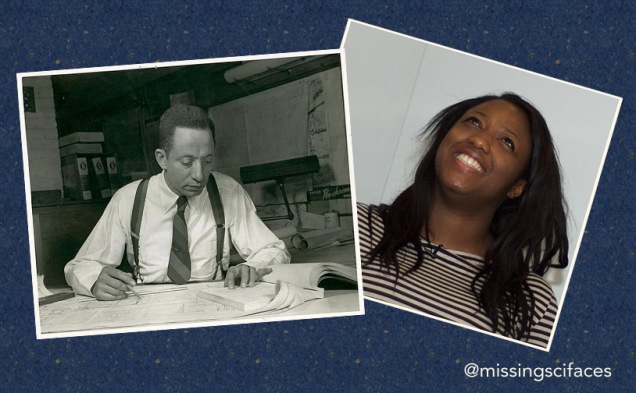
Harriet Marble‘s story was nearly lost. She doesn’t get a mention on this historical marker – even though she developed this medical and pharmacy center:

In 2009, though, an electrician doing work at her former home found some of her belongings in the attic. The building’s owner, Jim McKeighen, got curious – there was correspondence between Marble and Madame C.J. Walker, the first African-American woman to become a millionaire. I came across a newspaper story of what he found, when I was trying to find any trace of Marble after reading a small biographical entry for her in an old book.
Marble was born in 1885, and she was an early African-American woman pharmacist. She became a very successful businesswoman in Kentucky, and was served as Vice President of the National Medical Association. Check out her Wikipedia page – there’s not much to be found out about her on the internet, but there’s enough to know she led a fascinating life! I couldn’t find a photo – I hope someone does some digging and finds one.
A second new scientist added to Wikipedia this round is a Canadian-born, African-American entomologist, Jessica Ware. I first read about Ware in the terrific, Memoirs of Black Entomologists, and you might have seen her in the media – she was a featured scientist at the D.C. March for Science. She is an expert in dragonflies and has done highly cited work on phylogenomics of insect evolution. People from her lab responded to the request for a photo – thanks, Ware Lab!
In other news, Alma Levant Hayden, likely the first African-American FDA scientist, was featured for a day on the Wikipedia main page (here’s the screenshot). Her Wikipedia page got nearly 12,000 views that day, and nearly 6,000 the day after! Which was enough for her to make the Wikipedia “Did you know?” page view leaders’ list for June 2017.
And there’s more to check out since the last post.
New images slideshow
Hilyard Robinson (1899-1986), architect and engineer, who was influenced by his time in Europe – first as a soldier in World War I, then studying there, including Bauhaus style. Among his notable work is designing the Langston Terrace Dwellings, as part of FDR’s social works projects.
Juanita Merchant is a physiologist and professor at the University of Michigan, who has contributed to understanding the stomach’s response to chronic inflammation.
Jessica Ware – entomologist, discussed above.
Anne-Marie Imafidon (b. 1990), a mathematics, computing, and languages child prodigy, entered Oxford University at age 15, becoming its youngest-ever master’s degree graduate at 19. She launched, and is CEO of, Stemettes, an English social enterprise encouraging young girls’ interest in STEM careers.
Featured scientist needing an image
New scientists’ pages on Wikipedia
Some more scientists Wikipedians have added:
Sheila Miyoshi Jager (b. 1963) is an anthropologist and professor of East Asian Studies at Oberlin College.
Malado Kaba (b. 1971) is an economist who is finance minister in Guinea. (Needs a photo.)
Pilai Poonswad (b. 1946) is an ornithologist and biologist, and professor at Mahidol University, Thailand. She recruited poachers to help conserve declining hornbills and their forest habitat. (Her page needs a photo, too.)
Cecilia Lo studies congenital heart defects. She’s a professor and chair of the Developmental Biology Department at the University of Pittsburgh. (Photo needed.)
Maria Fernanda Botelho, born in Portugal, is a mathematician and professor at the University of Texas. (Her page needs a photo.)
Bridget Terry Long is an African-American economist and professor at Harvard, and former chair of the National Board of Education Science. (Her page needs a photo, too.)
Sian Proctor is an African-American geologist, science communicator and educator, who almost made it into NASA’s astronaut program.
Other faces slideshow
While looking for scientists’ faces, you come across others who are missing from Wikipedia that need to be added. Lately, they included:
Virginia Randolph (1870-1958), her parents had been enslaved – she was born 9 years after the end of the Civil War. Randolph had an extraordinary career as an innovative educator, “creating a successful formula based on practicality, creativity, and involvement of parents and community”.
Richard Theodore Greener (1844-1922), was the first African-American graduate at Harvard and dean of its School of Law, who became a diplomat, serving in Russia during the Russo-Japanese war.
Charlotte Louise Bridges Forten Grimké (1837-1914), anti-slavery activist, poet, and educator, from a prominent African-American family. During the Civil War, she was present when the all-Black 54th Regiment stormed Fort Wagner. Grimké participated in her minister husband’s work, and chronicled her life and times.
J. Vance Lewis (?-1925) was enslaved, freed as a result of the Emancipation when he was about 10. He became a lawyer, admitted to the bar of the U.S. Supreme Court. Lewis wrote an autobiography.
Mary Burnett Talbert (1866-1923) was one of the most famous African-Americans of her time. She was an educator, orator, civil rights and anti-lynching activist, suffragist, and reformer. Talbert graduated from Oberlin College, the only African-American student there at the time. She was one of the founders, along with W.E.B. DuBois, of the Niagara Movement, a pioneering civil rights group.
Edward Elder Cooper (1859-1908), born into slavery, became one of the first African-American publishers, publishing the first illustrated black newspaper in the U.S., the Indianapolis Freeman and later the DC paper, The Colored American.
Inspired? Read and share stories – and check out “How to Help” if you would like to add images and stories to Wikipedia.
Hilda Bastian

